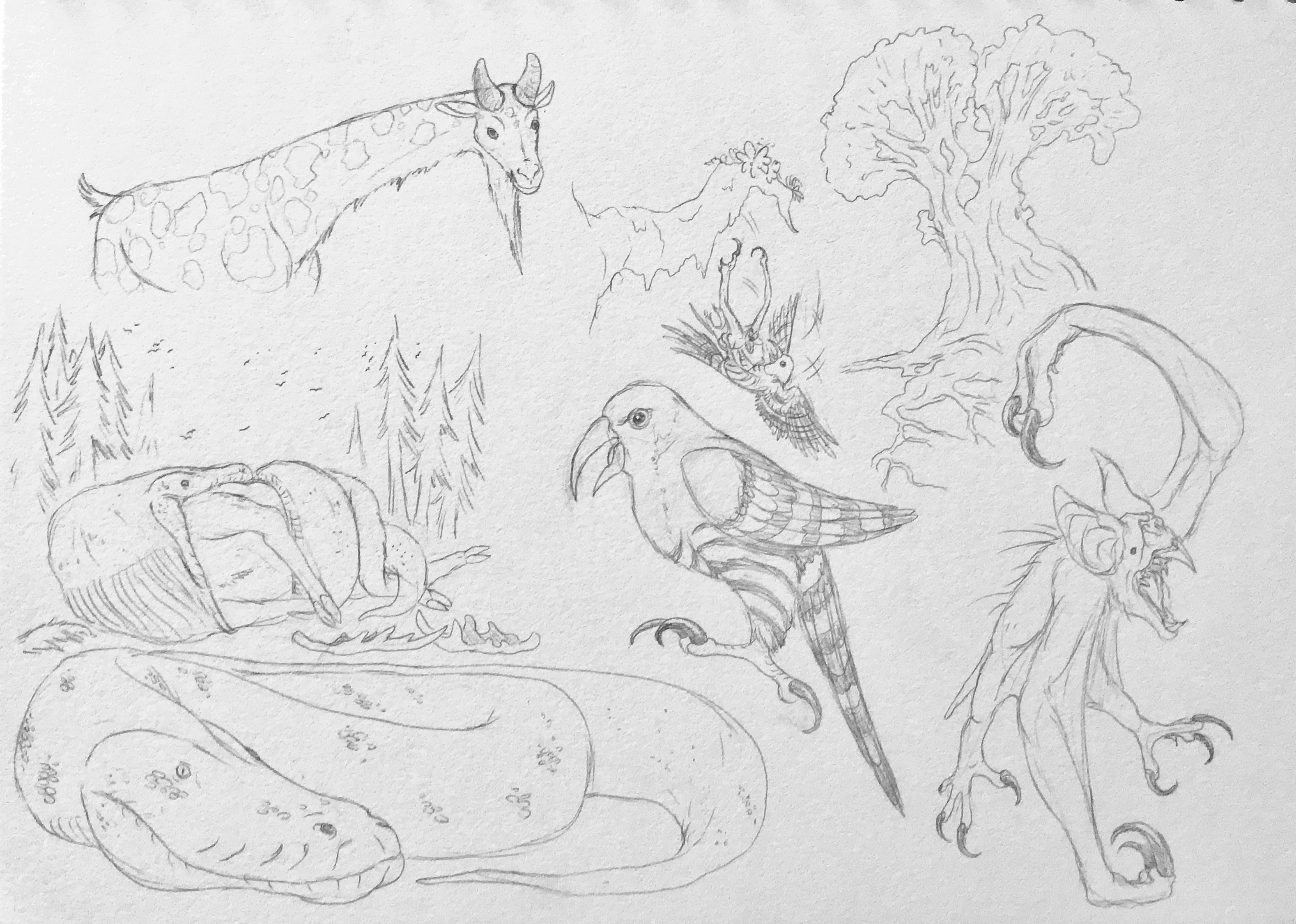HOME | DD
 ArtMakerProductions — Post Apocalypse Idea (#14)
ArtMakerProductions — Post Apocalypse Idea (#14)

#drawing #sketch #apocalypse #pencildrawing #pencilsketch #postapocalypse #sketchdrawing #speculativeevolution #speculativebiology #speculativezoology #apocalypticfantasy #apocalypseworld
Published: 2021-09-07 20:45:29 +0000 UTC; Views: 12469; Favourites: 88; Downloads: 0
Redirect to original
Description
False Giraffe - Already under pressure from human encroachment, climate change, and poaching operations, what little remained of Earth's megafaunal species sadly succumbed to the relentless onslaught of extinction once the bombs were dropped. In doing so, hundreds of other species who depended on them, whether or directly or inadvertently, also went extinct or suffered greatly. Some however, benefited greatly. As one of the most problematic invasive species back in the Age of Humanity, goats are natural-born survivors that are able to eat just about any plant matter, regardless of how appetizing it may or may not be to other, more delicate herbivores. Their sharp horns, preference for high places, and intelligence also makes them particularly difficult for predators to take them as prey items. All of this, combined with a lack of large herbivores, allowed caprins to rapidly diverge into a variety of species, the largest of which is the False Giraffe. As their name implies, these enormous herbivores can reach heights of over twenty feet in part due to their long neck and legs that allow them to feast on the canopies of the megarainforests that now cover the planet. With a dappled coat of splotches and spots to provide minimal camouflage, a devastating kick powerful enough to shatter skulls, and the ability to affect the shape and state of their habitat, False Giraffes have few predators capable of taking them on.Artist's Note: their spots are more akin to these, than those of a true giraffe: i.pinimg.com/originals/32/ef/2… , i.pinimg.com/originals/f0/50/9…
Description by CreaturemasterProds
Megamouth Python - Pythons that, as their namesake suggests, have enormous mouths and have grown to sizes far beyond that of the prehistoric relative, the Titanoboa. Living in large bodies of water for all their life. Hardly ever moving at all, remaining completely stationary for months, even years at a time. Only resurfacing briefly for breaths of air. Ever waiting so patiently for any of the unfortunate megafauna to stop by for a drink. Never taking any chances unless they're absolutely sure it'll be worth it as going in for the kill takes a lot of energy for a creature of such size. These monstrously large beasts only ever travelling great distances when they're newly born. Here we see an individual swallowing a Colossibou, a giant of the deer family. Breaking off the antlers beforehand as to not be killed while ingesting the meal. Such a kill will satisfy it for years at a time. It doesn’t bother w/ anything small or human sized as it would be a waste of it’s energy.
False Oak Tree - Eukaryotic organisms, otherwise known as "Slime Molds", that have flourished in the earth's equator that has become a hothouse in the new modern world. Having taken the shape of trees. Their "roots" stretch far and wide for many miles. Unusually taking root outside the territory of other False Oaks as to avoid competition. Consuming dead fauna and flora. Occasionally supplementing their diet w/ living animals that they have ensnared in their "leaves".
Parakeetgle - Birds of prey often due poorly in cataclysmic situations due to their precarious position at the top of the food chain, whether that is a result of lack of food or accumulator poisoning from eating large amounts of vermin containing pesticides from the plants they eat. The fact that humanity has a habit of clearing away the pristine wilderness they need to survive only aggravates the situation further; thus, it's little wonder that many birds of prey have gone extinct since the bombs fell. In their absence however, the monk parakeet gave rise to a descendant just as fearsome. Previously considered an invasive species as a result of abandoned pets or escaped flocks, monk parakeets were one of the few parrot species that could tolerate cold climates due to their communal nesting habits, allowing them to survive in places as far North as New York and Wisconsin. Without birds of prey to hunt them, the monk parakeet was able to take over their ecological niche and become the Parakeagle.Parakeagles are about the size of a large hawk or small eagle, having not quite managed to reach the sizes that some birds of prey were able to reach just quite yet. They possess black-banded feathers on their legs and wings, leading to some humans dubbing them as "zebra hawks". While they retain some of their green plumage, their beaks have changed significantly, having become more adapted for tearing through flesh or punching through the skulls of the small mammals they eat, such as the Flying Ghoul Monkey. The claws have also become larger and more curved, giving them a good grip on their prey as they fly off with it, only to drop it from a tremendous height in order to kill it. Once done, they typically eat where it lands, as carrying it back to the nest is rather exhaustive work, though not unheard of fore small enough animals. Unlike their ancestors however, Parakeagles are solitary and only come together when breeding, though they have been known to gather in groups around large kills.
Artist's Note: Used the Kea and Pesquet’s parrot as reference. Here we see an individual snatching a Flying Ghoul Monkey right out of the air.
Description by CreaturemasterProds
Revenant Ghoul Monkey - A large relative of the much smaller Flying Ghoul Monkey, these highly derived chriopterrids are some of the most ferocious and deadly predators the megarainforests of this new Earth have to offer. Occasionally referred to as "Chupacabras" by human survivors, they stalk the canopies at night using their sophisticated echolocation to map out the labyrinth of branches in order to compensate for their comparatively poor eyesight. With sharp claws and grasping fingers derived from their ancestor's wings, they swiftly swing through the trees in search of prey, such as Flying Ghoul Monkeys. Traveling in packs however, and using their high-pitched calls to prevent potential prey from hearing the approaching danger, they are able to take on much larger animals with ease - and they seem to have a particular taste for unwary humans who may find themselves stumbling around alone in the forest at night.
Artist's Note: Like their thumb, the index finger has an elongated claw for assistance of latching onto prey. As they spend more time on the ground than their smaller relatives they've developed a knuckle-based walk like the gorilla. Having more muscule in their arms for their hunting.
Description by CreaturemasterProds
Related content
Comments: 3

👍: 2 ⏩: 1

👍: 1 ⏩: 1

👍: 2 ⏩: 0

























